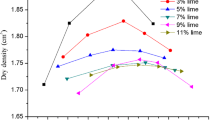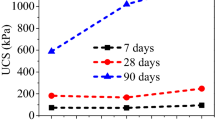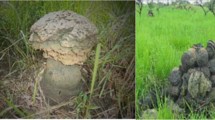Abstract
Because of its poor engineering properties, silt often needs to be treated to meet the design requirements. Solidification using binder is one of the most common methods to improve the engineering properties of silt. Lime or/and cement are often used to treat silt. However, the mechanical properties of soil are closely related to its microstructure. Although much research has been done on the mechanical properties and stabilization mechanism of lime or/and cement solidified silt, the multi-scale research between the microstructure and macroscopic mechanics properties of solidified silt has received no attention. Therefore, in this paper, unconfined compression, mercury intrusion, and scanning electron microscope (SEM) tests were conducted on lime, cement, and lime and cement mixtures (LC) solidified silt. The microstructure parameters of particle, pore, and contact zone were extracted from SEM images. Meanwhile, the effect of curing time and binder dosage on the microstructure parameters was analyzed. In addition, the relationship between micro-parameters and macro-mechanical strength was established. The results showed that the particle diameter, particle area, contact zone diameter, and contact zone area increased with increasing curing time and binder dosage, while the pore ratio, fractal dimension of particle size distribution (PSD), and fractal dimension of contact zone size distribution (CZSD) decreased with increasing binder dosage. The unconfined compressive strength (UCS) decreased with the increase of particle roundness, pore area, pore diameter, pore ratio, and fractal dimension of PSD, and increased with increasing fractal dimension of pore size distribution (PPSD). In addition, there were no obvious relationships between UCS and pore roundness, contact zone area, and fractal dimension of CZSD.























Similar content being viewed by others
Abbreviations
- A g :
-
Particle area
- R g :
-
Particle roundness
- A p :
-
Pore area
- R p :
-
Pore roundness
- A c :
-
Area of contact zone
- R c :
-
Roundness of contact zone
- q u :
-
Unconfined compression strength
- PSD:
-
Particle size distribution
- PPSD:
-
Pore size distribution
- n p :
-
Pore area ratio from SEM images
- D g :
-
Particle diameter
- FD g :
-
Fractal dimension of particle size distribution
- D p :
-
Pore diameter
- FD p :
-
Fractal dimension of pore size distribution
- D c :
-
Diameter of contact zone
- FD c :
-
Fractal dimension of contact zone size distribution
- IPP:
-
Image Pro Plus
- CZSD:
-
Contact zone size distribution
- LC:
-
Lime and cement mixtures
References
Anderson AN, Mcbratney AB, Fitzpatrick EA (1996) Soil mass, surface, and spectral fractal dimensions estimated from thin section photographs. Soil Sci Soc America J 60:962–969
ASTM (2002) ASTM designation D4404. Standard test method for determination of pore volume and pore volume distribution of soil and rock by mercury intrusion porosimetry. In: Annual book of ASTM standards
ASTM (2008) Standard test method for unconfined compressive strength index of chemical-grouted soils. ASTM standard D4219-08. American society for testing and materials, west Conshohocken, Pa
ASTM (2012) D698-12, standard test methods for laboratory compaction of soil standard effort. ASTM International, West Conshohocken, ASTM International, West Conshohocken, Pennsylvania
ASTMD (2010) Standard test methods for liquid limit, plastic limit and plasticity index of soils, ASTM International, West Conshohocken, Pennsylvania
Benavente N, Pina P (2009) Morphological segmentation and classification of marble textures at macroscopical scale. COMPUT GEOSCI-UK 35:1194–1204
Bouazza A, Kwan PS, Chapman G (2004) strength properties of cement treated Coode Island silt by the soil mixing method. In: GeoTrans 2004
Bushell GC, Yan YD, Woodfield D, Raper J, Amal R (2002) On techniques for the measurement of the mass fractal dimension of aggregates. ELSEVIER, Netherlands, p 1
Cai G, Tao Z, Liu S, Li J, Jie D (2014) Stabilization mechanism and effect evaluation of stabilized silt with lignin based on laboratory data. Mar Georesour Geotechnol 34:1390578475
Cotecchia F, Guglielmi S, Cafaro F, Gens A (2019) Characterisation of the multi-scale fabric features of high plasticity clays. pp 361-368
Dal Ferro N, Sartori L, Simonetti G, Berti A, Morari F (2014) Soil macro- and microstructure as affected by different tillage systems and their effects on maize root growth. Soil Tillage Res 140:55–65
Dathe A, Eins S, Niemeyer J, Gerold G (2001) The surface fractal dimension of the soil–pore interface as measured by image analysis. Geoderma 103:229
Deneele D, Le Runigo B, Cui Y, Cuisinier O, Ferber V (2016) Experimental assessment regarding leaching of lime-treated silt. Constr Build Mater 112:1032–1040
Dougan LT, Addison PS (2001) Estimating the cut-off in the fractal scaling of fractured concrete. PERGAMON PRESS, Great Britain, p 1043
Dudoignon P, Gélard D, Sammartino S (2004) Cam-clay and hydraulic conductivity diagram relations in consolidated and sheared clay-matrices. Clay Miner 39:267–279
Ferber V, Auriol JC, Magnan JP, Cui YJ, De Laure E, Gerente C (2006) A microstructural model for the volume changes of unsaturated clayey soils due to wetting. Reston, Va.; [Great Britain]:; American Society of Civil Engineers. P 861
Fernández-Martínez M, Sánchez-Granero MA (2016) A new fractal dimension for curves based on fractal structures. Topol Appl 203:108–124
Gantzer CJ, Anderson SH (2002) Computed tomographic measurement of macroporosity in chisel-disk and no-tillage seedbeds. Soil Tillage Res 64:101–111
Ghalehjough BK, Akbulut S, Celik S (2017) Experimental and numerical investigation on bearing capacity of granular soil affected by particle roundness. Indian J Mar Sci 46:2137–2145
Giménez D, Allmaras RR, Nater EA, Huggins DR (1997) Fractal dimensions for volume and surface of interaggregate pores—scale effects. Geoderma 77:19–38
H WZ, H X (2003) Direct estimation of the fractal dimensions of a fracture surface of rock. Surface Review and Letters (SRL):751
Hu R, Yeung M, Lee C, Wang S (2001) Mechanical behavior and microstructural variation of loess under dynamic compaction. Eng Geol 59:203–217
Ikhlef NS, Ghembaza MSN, Dadouch M (2015) Effect of treatment with cement on the mechanical characteristics of silt from Telagh region of Sidi Belabes, Algeria. Geotech Geol Eng 33:1067–1079
Jiao K, Yao S, Liu C, Gao Y, Wu H, Li M, Tang Z (2014) The characterization and quantitative analysis of nanopores in unconventional gas reservoirs utilizing FESEM–FIB and image processing: an example from the lower Silurian Longmaxi shale, upper Yangtze region, China. Int J Coal Geol 128-129:1–11
Juang CH, Holtz RD (1986) A probabilistic permeability model and the pore size density function. Int J Numer Anal Methods Geomech 10:543–553
Kikkawa N, Orense RP, Pender MJ (2013) Observations on microstructure of pumice particles using computed tomography. Can Geotech J 50:1109–1117
Kim HM, Anderson SH, Motavalli PP, Gantzer CJ (2010) Compaction effects on soil macropore geometry and related parameters for an arable field. Geoderma 160:251
Koerner RM (1970) Effect of particle characteristics on soil strength: R.M. Koerner. J. Soil Mech. Fndns. Div., Proc. ASCE96, SM 4, 1221–1234 (July 1970)
Kong X, Song S, Wang M, Zhao Q (2019) Experimental research of low liquid limit silt stabilized by lignin in the flooding area of Yellow River. Geotech Geol Eng 37:5211
Krohn C, Thompson A (1986) Fractal sandstone pores: automated measurements using scanning-electron-microscope images. Phys Rev B 33:6366–6374
Kumar R, Bhattacharjee B (2003) Porosity, pore size distribution and in situ strength of concrete. Cem Concr Res 33:155–164
Leroueil S, Vaughan PR (1990) The general and congruent effects of structure in natural soils and weak rocks. Géotechnique 40(3):467–488
Liang SH, Lu YD, Pan WS, Zhang XZ (2020) Study on microstructure of red clay in southern Guizhou province based on SEM. Water Resour Power 38(2) in Chinese
Liu ZB, Shi B, Inyang HI, Cai Y (2005) Magnification effects on the interpretation of SEM images of expansive soils. Eng Geol 78:89–94
Liu C, Shi B, Zhou J, Tang C (2011a) Quantification and characterization of microporosity by image processing, geometric measurement and statistical methods: application on SEM images of clay materials. Appl Clay Sci 54:106
Liu C, Shi B, Zhou J, Tang C (2011b) Quantification and characterization of microporosity by image processing, geometric measurement and statistical methods: application on SEM images of clay materials. 54:106
Matsushima T, Uesugi TKA, Nakano T (2004) Detection of 3-D irregular grain shape of Toyoura sand at SPring-8. In X-ray CT for Geomaterials. Soils, Concrete, Rocks:121–126
MCPRC (2009) Ministry of Communications of the People’s Republic of China. Test methods materials stabilized with inorganic binder materials for highway engineering. China communication press, Beijing
Nez-Nistal AM, Veniale F, Setti M, Cotecchia F (1999) A scanning electron microscopy image processing method for quantifying fabric orientation of clay geomaterials
Pan LS, Zhou RC (2013) Microscopic features of mudstone based on SEM images. Durnten-Zurich; Trans Tech publications Ltd p 1130
Pan J, Niu Q, Wang K, Shi X, Li M (2016) The closed pores of tectonically deformed coal studied by small-angle X-ray scattering and liquid nitrogen adsorption. Microporous Mesoporous Mater 224:245–252
Peng Z, Jing S (2017) Correlation relationship analysis of physical mechanics properties and pores microstructures
Penumadu D (1996) Evaluating clay microfabric using scanning electron microscopy and digital information processing. NATIONAL ACADEMY OF SCIENCES: United States. p 112
Peyton RL, Gantzer CJ, Anderson SH, Haeffner BA, Pfeifer P (1994) Fractal dimension to describe soil macropore structure using X ray computed tomography. Water Resour Res 30:691–700
Pradhan B, Nagesh M, Bhattacharjee B (2005) Prediction of the hydraulic diffusivity from pore size distribution of concrete. Cem Concr Res 35:1724–1733
Prakongkep N, Suddhiprakarn A, Kheoruenromne I, Gilkes RJ (2010) SEM image analysis for characterization of sand grains in Thai paddy soils. GEODERMA 156:20–31
Pu SY, Zhu Z, Song W, Wang H, Wei R (2019a) Deformation properties of silt solidified with a new SEU-2 binder. pp 267-277
Pu SY, Zhu Z, Wang H, Song W, Wei R (2019b) Mechanical characteristics and water stability of silt solidified by incorporating lime, lime and cement mixture, and SEU-2 binder. Constr Build Mater
Pu SY, Zhu Z, Song W, Wan Y, Wang H, Xu X (2020a) Comparative study of compressibility and deformation properties of silt stabilized with lime, lime, and cement, and SEU-2 binder. Arab J Sci Eng:1
Pu SY, Zhu ZD ,Song WL, Wan Y,Wang HR, Song SG, Zhang J (2020b) Mechanical and microscopic properties of cement stabilized silt,KSCE Journal of Civil Engineering
Pusch R, Weston R (2003) Microstructural stability controls the hydraulic conductivity of smectitic buffer clay. Appl Clay Sci 23:35–41
Qinghui L, Jiajia Y, Jian Z, Zhigang C (2016) Microstructure study on intact clay behavior subjected to cyclic principal stress rotation. Procedia Engineering 143:991–998
Shen Y, Yang H, Xi J, Yang Y, Wang Y, Wei X (2020) A novel shearing fracture morphology method to assess the influence of freeze–thaw actions on concrete–granite interface
Shi B, Murakami Y, Wu Z (1998) Orientation of aggregates of fine-grained soil: quantification and application. Eng Geol 50:59–70
Shi X, Pan J, Hou Q, Jin Y, Wang Z, Niu Q, Li M (2018) Micrometer-scale fractures in coal related to coal rank based on micro-CT scanning and fractal theory. FUEL 212:162–172
Sivakumar V, Doran IG, Graham J (2002) Particle orientation and its influence on the mechanical behaviour of isotropically consolidated reconstituted clay
Tang YQ, Jie Z, Hong J, Ping Y, Wang JX (2012) Quantitative analysis of the microstructure of Shanghai muddy clay before and after freezing. Bull Eng Geol Environ 71:309–316
Tao, Zhang, Songyu, Liu, Guojun, Cai, Anand, J., Puppala (2015) Experimental investigation of thermal and mechanical properties of lignin treated silt. Eng Geol
Tovey NK, Krinsley DH (1992) Mapping of the orientation of fine-grained minerals in soils and sediments. Bull Eng Geol Environ 46:93–101
Yilmaz E, Belem T, Bussière B, Benzaazoua M (2011) Relationships between microstructural properties and compressive strength of consolidated and unconsolidated cemented paste backfills. Cem Concr Compos 33:702–715
You Z, Lai Y, Zhang M, Liu E (2017) Quantitative analysis for the effect of microstructure on the mechanical strength of frozen silty clay with different contents of sodium sulfate. Environ Earth Sci 76:141–143
Zhang ZL, Cui Z (2017) Analysis of microscopic pore structures of the silty clay before and after freezing–thawing under the subway vibration loading. Environ Earth Sci 76:528
Zhang T, Cai G, Liu S, Puppala AJ (2016) Engineering properties and microstructural characteristics of foundation silt stabilized by lignin-based industrial by-product. KSCE J Civ Eng 20:2725–2736
Zhou H, Wu JH (2017) Study of soil pore fractal features in the process of soil consolidation and its impact on permeability. Industrial Building 08:95–99
Zhu ZD, Liu S (2008) Utilization of a new soil stabilizer for silt subgrade. Eng Geol 97:192–198
Author information
Authors and Affiliations
Corresponding authors
Rights and permissions
About this article
Cite this article
Pu, S., Zhu, Z., Zhao, L. et al. Microstructural properties and compressive strength of lime or/and cement solidified silt: a multi-scale study. Bull Eng Geol Environ 79, 5141–5159 (2020). https://doi.org/10.1007/s10064-020-01910-y
Received:
Accepted:
Published:
Issue Date:
DOI: https://doi.org/10.1007/s10064-020-01910-y




